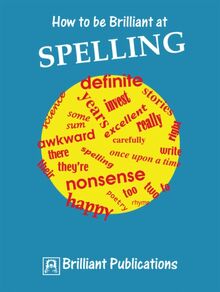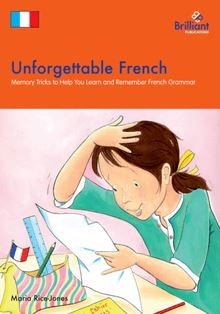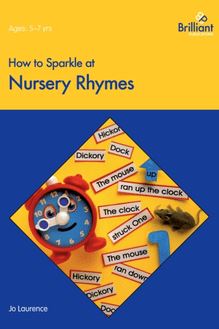Unforgettable French , livre ebook
150
pages
English
Ebooks
2013
Vous pourrez modifier la taille du texte de cet ouvrage
Obtenez un accès à la bibliothèque pour le consulter en ligne En savoir plus
Découvre YouScribe en t'inscrivant gratuitement
Découvre YouScribe en t'inscrivant gratuitement
150
pages
English
Ebooks
2013
Vous pourrez modifier la taille du texte de cet ouvrage
Obtenez un accès à la bibliothèque pour le consulter en ligne En savoir plus
Publié par
Date de parution
25 avril 2013
Nombre de lectures
3
EAN13
9780857475978
Langue
English
Poids de l'ouvrage
1 Mo
Publié par
Date de parution
25 avril 2013
Nombre de lectures
3
EAN13
9780857475978
Langue
English
Poids de l'ouvrage
1 Mo
Title Page
UNFORGETTABLE FRENCH
Memory Tricks to Help You Learn and Remember French Grammar
Maria Rice-Jones
Publisher Information
Originally published in the UK in 2010 by
Brilliant Publications
Unit 10, Sparrow Hall Farm, Edlesborough, Dunstable, Bedfordshire, LU6 2ES, UK
Tel: 01525 222292
E-mail: info@brilliantpublications.co.uk
Website: www.brilliantpublications.co.uk
Digital version converted and published in 2011 by
Andrews UK Limited
www.andrewsuk.com
The name Brilliant Publications and the logo are registered trademarks.
Written by Maria Rice-Jones
Illustrated by Sarah Wimperis
Cover illustration by Frank Endersby
Front cover designed by Brilliant Publications
© Text Maria Rice-Jones 2010
© Design Brilliant Publications 2010
The right of Maria Rice-Jones to be identified as the author of this work has been asserted by herself in accordance with the Copyright, Designs and Patents Act 1988.
Certain indicated sections may be printed/photocopied by individual teachers acting on behalf of the purchasing institution for classroom use only, without permission from the publisher. The materials may not be reproduced in any other form or for any other purpose without the prior permission of the publisher.
About the Author
Maria Rice-Jones is a French national with a Master’s Degree in Modern Languages from the Sorbonne University in Paris. Since 1990, she has taught French to both children and adults in Paris, Milan and London. She has also written Hexagonie: An Innovative Way of Teaching French , a comprehensive method for teaching French in primary and lower secondary schools using memory tricks.
Introduction
Unforgettable French uses memory tricks to teach and reinforce major points of French grammar from the basics up to GCSE level, to learners of all ages. It may be used:
•By anyone who wishes to gain confidence in speaking French
•As a revision aid, to consolidate the learner’s grasp of grammatical points
•To complement whatever French scheme you are using
•By French teachers at all levels, from primary through to adult.
Unforgettable French is full of memory tricks to help you engage your memory and remember key grammatical points. Over the years, I have developed my tried-and-tested memory tricks based on sound and idea associations. I have found that using memory tricks to explain “tricky” bits facilitates the learning process and what seemed difficult before is suddenly much easier to remember.
My memory tricks in Unforgettable French are presented in a highly visual, page-by-page format. The sheets can be enlarged to make mini-posters or used as “aide-mémoires”. My memory tricks are deliberately funny or shocking so that our brains can remember. Let me give you some examples:
The verb “to hide” in French is “cacher”. To remember it, imagine that you hide your cash, and “cash” reminds us of “cacher”.
“Cher” means “expensive” and if something is expensive then we want to “share” the expense.
The way to remember that we say “au” with ball sports - “je joue au football” (I play football) - is to remember that “au” sounds like “o” - which looks like a ball.
If you are an adult, the illustrations and the stories about the imaginary land of Hexagonie might seem childish. This is on purpose as children seem to have greater imaginations than adults. So, please don’t be put off by the illustrations and stories as they will help you to visualize the language better. Instead, think like a child again and start to enjoy playing with the language.
My method of teaching is now used successfully in many schools in the UK.
Enjoy!
Maria Rice-Jones
L’alphabet (The alphabet)
This page may be printed/photocopied for use by the purchasing institution only.
© Maria Rice-Jones and Brilliant Publications
Names that start with the sounds of the alphabet in French
A
=
(ah)
Anne
B
=
(bay)
Béatrice
C
=
(say)
Céline
D
=
(day)
Déborah
E
=
(uh)
Ernest
F
=
(eff)
Efna
G
=
(jay)
Gérard
H
=
(ash)
Ashley
I
=
(ee)
Isabelle
J
=
(gee)
Gisèle
K
=
(ka)
Karen
L
=
(ell)
Elena
M
=
(emm)
Emma
N
=
(enn)
Enzo
O
=
(oh)
Olivier
P
=
(pay)
Penny
Q
=
(kew)
Cupidon
R
=
(airrr)
Erin
S
=
(ess)
Esther
T
=
(tay)
Teresa
U
=
(ew)
Una
V
=
(vay)
Véronique
W
=
(doobluh vay)
X
=
(eeks)
Y
=
(ee-graik)
Z
=
(zaid)
Zed
Common abbreviations
un C.D. une T.V. un W.C. un T.G.V.
Hexagonie story: Les accents (Accents)
This page may be printed/photocopied for use by the purchasing institution only.
© Maria Rice-Jones and Brilliant Publications
Stories about the imaginary land of Hexagonie , where the inhabitants are parts of speech, will help you to visualize the language. Read this story about French accents.
Keep your hat on!
Hello, nice to meet you! I am the verb Voyager. As you can probably tell from my name, I love to travel and discover new places. I’d like to tell you about my visit to the country of Hexagonie.
On my first day, I saw all the letters of the alphabet parading in front of the royal family. My attention was drawn to the letter “e” who was obviously making an effort to impress them with her three different hats.
The first hat sloped upwards to the right (é) and was called an “acute”.
The second hat sloped upwards to the left (è) and was called a “grave”.
The third, which was called a “circumflex”, looked as if the two sloping hats had been joined to form a cone (ê).
King Être and Queen Avoir were so impressed by the letter “e” and her hats that they asked her to come forward and introduce herself. The letter “e” showed them her hats, one by one, and each time she changed her hat, she sounded a bit different.
I quickly realized that hats were very popular in Hexagonie. The “grave” hat was also worn by the letters “a” (à) and “u” (ù). Then, all of a sudden, the letter “c” made a dramatic entrance wearing a funny dress. The dress looked a bit like a tail and was called a “cedilla” (ç). I had to stop myself from laughing out loud.
I wanted to find a way of remembering the two hats I liked the most: the “acute” and the “grave”. Then the story of “a cute monkey” came to mind. It was one I had been told on an earlier trip. In the story, “a cute monkey” goes up a tree to build his house, but sadly has a grave fall. Luckily for the monkey, he does not fall into his grave because after a while he is all right. Here is a quick sketch I have don








